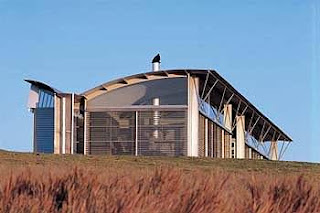When we hear Egyptian Architecture, what's the first thing that comes to mind? Pyramids of course. But there is more to Egyptian Architecture than just pyramids. They built different types of pyramids (slope, bent and step) and each one is unique. Also, when we see pyramids, we think that it's just there for 'design' or a monument such as the obelisk in Washington DC. The truth behind the pyramids is that they are actually burial grounds for the Egyptian Kings and Queens. The tallest and oldest pyramid, pyramid of Giza (which is still intact today), was believed to be built for the 4th dynasty Pharaoh Kfuhu. Over time, the pyramid has lost the outer surface of the pyramid, giving it the illusion of a step pyramid, when in reality, it is a Slope Pyramid.
The pyramid was considered as the final stage of a Burial Place. At first, the Egyptians put their dead in tombs called 'Mastaba'. The Mastaba was a basic, rectangular tomb which included a chapel, and a serdab. The Egyptians then put a step pyramid over the Mastaba. Soon after, they decided to change the step pyramids into slope pyramids. It was an evolution, or a trial and error type of situation. The Egyptians built the pyramids believing that it was a necessity to have a good life-after-death experience.
As I have mentioned with my previous reaction papers, each building or structure has its own purpose. The Babylonians built on platforms to avoid malaria, during the prehistoric age, they built their shelter with what they had around them. The Egyptians built their structures mostly based on religious influence. The Pharaohs believed that having a pyramid was a necessity for life-after-death. They believed that being buried in a gold sarcophagus and having luxurious items buried with you will translate to a better life after death. This new view of architecture has caught my eye mainly because I was so one tracked mind with structures, I believed that I was limited to just designing for shelter. I never really thought of designing structures just for the sake of it (such as the obelisk or sphinx.). I didn't think religion could translate into architecture. Again, this whole thing is a learning experience for me, as I wasn't really exposed to much architecture or structures outside (unless lego counts). One knowledge or fact I can take away from the Egyptian Architecture is that structures actually go deeper than just how they appear. They may have a meaning to why it is constructed that way.









